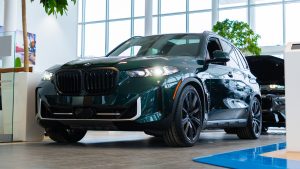Wondering what the difference is between the different types of electric vehicles (EVs)? We’ll break down the main types of electric vehicles, including BEVs, PHEVs, and HEVs explaining what each one stands for, how they work, and what makes them unique to help you choose the EV that is best for you!
1. Battery Electric Vehicles (BEV)
Battery Electric Vehicles (BEVs) are 100% electric vehicles powered entirely by a rechargeable battery, without an internal combustion engine. These vehicles store energy in large battery packs, which power an electric motor. BEVs are charged by plugging into an electric outlet or charging station and typically offer a driving range between 250 to over 500 km per charge, depending on the model.
Charging can be done at home using a standard 120V outlet (Level 1 charger), which offers slower charging speeds, or a 240V outlet (Level 2 charger), which is much faster. Fast-charging stations (Level 3 chargers) are also available in public spaces, enabling drivers to replenish up to 80% of the battery in as little as 30 minutes.
Read more: The Difference Between Level 1, Level 2, and Level 3 Charging Stations
When to Choose a BEV:
A BEV is ideal for drivers who are interested in reducing their carbon footprint, eliminating gasoline costs, and who have access to charging infrastructure, whether at home, work, or public stations in urban areas.
Examples of BEVs:
- Hyundai KONA EV
- Hyundai IONIQ 5
- Kia EV6
- Kia EV9
- Chevrolet Blazer EV
- Chevrolet Equinox EV
- Tesla Model 3

2. Plug-In Hybrid Electric Vehicles (PHEV)
Plug-in Hybrid Electric Vehicles (PHEVs) combine the best of both worlds: an electric motor and a traditional gasoline engine. These vehicles operate in full-electric or hybrid modes, seamlessly switching between electric and gasoline. PHEVs have a larger battery than traditional hybrids, allowing them to travel short distances (usually 30-70 km) on electric power alone. When the battery is low, the gasoline engine takes over, giving you the range and flexibility of a conventional vehicle.
You can recharge the battery of a PHEV by plugging into an electric charging station or an outlet at home. PHEVs also offer regenerative braking which allows the vehicle to recover electric energy during braking and increase your driving range.
When to Choose a PHEV:
A PHEV is ideal for drivers who want the environmental benefits of electric driving but need the flexibility of a gasoline engine for longer distances. If you have regular access to charging at home or work, and your daily commute is short, a PHEV can significantly reduce your fuel consumption.
Examples of PHEVs:
- Toyota RAV4 Plug-in Hybrid
- Ford Escape Plug-in Hybrid
- Kia Niro Plug-in Hybrid
- Jeep Wrangler Plug-in Hybrid
- Dodge Hornet Plug-in Hybrid
- Volvo XC60 Recharge

3. Hybrid Electric Vehicles (HEV)
Hybrid Electric Vehicles (HEVs) operate using a combination of a gasoline-powered internal combustion engine and a small electric motor. Unlike plug-in hybrids or fully electric vehicles, HEVs do not need to be plugged in to charge the battery. Instead, the battery is recharged through regenerative braking and by the engine while driving.
HEVs often switch between the gas engine and the electric motor depending on the driving conditions. For example, at low speeds or when idling in traffic, the electric motor may take over, conserving fuel. On highways, the gasoline engine kicks in for sustained power. The transition between electric and gas power is seamless, offering better fuel efficiency, reduced emissions, and optimal performance compared to conventional gas-powered vehicles.
When to Choose an HEV:
HEVs are an excellent choice for drivers who want to reduce fuel consumption and emissions but don’t have easy access to charging stations. If you drive long distances or live in an area with limited charging infrastructure, an HEV can provide the perfect balance of efficiency and convenience. HEVs are also great for city driving, where regenerative braking helps maximize electric energy recovery.
Examples of HEVs:
- Honda CR-V Hybrid
- Honda Civic Hybrid
- Toyota Corolla Hybrid
- Kia Sportage Hybrid
- Hyundai Tucson Hybrid

Choosing the Right Electric Vehicle for You
When deciding between a BEV, PHEV, HEV, or another type of electric vehicle, consider the following factors:
Driving Range: BEVs are best if you want to go fully electric with the longest range. PHEVs and HEVs offer shorter electric ranges but more flexibility with gasoline backup.
Charging Infrastructure: If you have access to home or public charging stations, a BEV or PHEV may be ideal. If charging is less convenient, an HEV might be a better fit.
Environmental Impact: BEVs are the most eco-friendly, with zero tailpipe emissions.
Budget: EVs tend to have higher upfront costs, but the long-term savings in fuel and maintenance can offset the price.
At Birchwood Automotive Group, we offer a range of electric vehicles to suit your driving needs and lifestyle. Whether you’re looking for a fully electric car or a hybrid, our knowledgeable team can help you find the perfect fit and answer all your questions about transitioning to electric driving.
Ready to Go Electric?
Explore our selection of electric, hybrid, and plug-in hybrid vehicles today!


